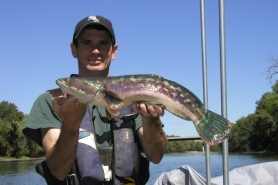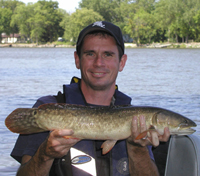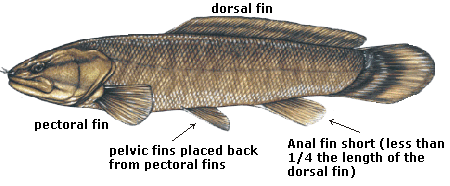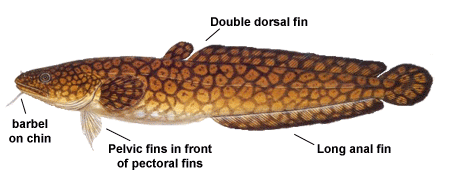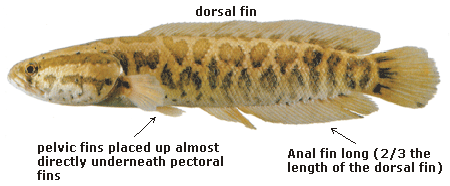Did I catch a snakehead?
Fishing Wisconsin
A reproducing population of northern snakehead, one of 28 species of fish native to Asia and Africa, was discovered in a suburban Maryland pond in 2002. The pond was eventually poisoned, killing all the snakehead fish.
In early September 2003, a DNR crew collected another species of an exotic snakehead fish, the giant snakehead, during routine sampling of the Rock River. The fish was more than likely released into the river after outgrowing its home aquarium space. This discovery has led to numerous calls and questions about snakehead fish.
Snakeheads may be confused with our native bowfin (dogfish) or burbot. Snakehead and bowfin body and fin shapes are very similar. However, there are two distinct differences:
- The snakehead's anal fin is long - about 2/3 the length of the dorsal fin, while the bowfin's anal fin is short - less than one quarter the length of the dorsal fin, and
- The snakehead's pelvic fins are found almost underneath the pectoral fins, while the bowfin's pelvic fins are set back from the pectoral fins. The burbot, like the snakehead, has a long anal fin and pelvic fins actually in front of the pectoral fins, however, the burbot has very fine scales and a conspicuous barbel under the chin.
The diagrams below should help distinguish between the three fish species.
Bowfin (native)
The bowfin (or dogfish) has a large mouth equipped with many sharp teeth. Its large head has no scales. The dorsal fin is long, extending more than half the length of the back. The tail is rounded. There is a barbel-like flap associated with each nostril. The back is mottled olive green shading to lighter green on the belly. The dorsal is dark green, while all others are light green. Young fish have a distinctive black spot near the base of the upper portions of the tail fin. The spot is usually margined with yellow or orange. Although it persists in adult fish, it is less prominent in females.
Burbot (native)
The burbot (or lawyer, eelpout, or freshwater cod) is an elongate, cylindrical fish with 2 dorsal fins, a long anal fin, and pelvic fins in front of the pectoral fins. Adults are uniformly yellow or light brown to black or mottled with dark brown or black on back and sides. Young fish conspicuously speckled with dark vermiculations. The dorsal, caudal, and anal fins are mottled. The burbot frequents cool waters of large rivers, and the lower reaches of their tributaries, and lakes -- particularly in northern Wisconsin.
Snakehead (exotic)
The giant (or red) snakehead is an aggressive predator that feeds on fish, frogs, aquatic birds, and, in some cases, small mammals. It grows up to 40 inches and can weigh over 15 pounds. The fish is able to survive in waters with very low dissolved oxygen and if faced with deteriorating environmental conditions, can actually move over land and has been known to survive out of water for periods of 3-4 days. Snakeheads are common fish in the pet-trade industry and favored by Asian fish markets for its delicate flesh.
Did I just catch a snakehead? Fisheries publication FH-715 [PDF]

